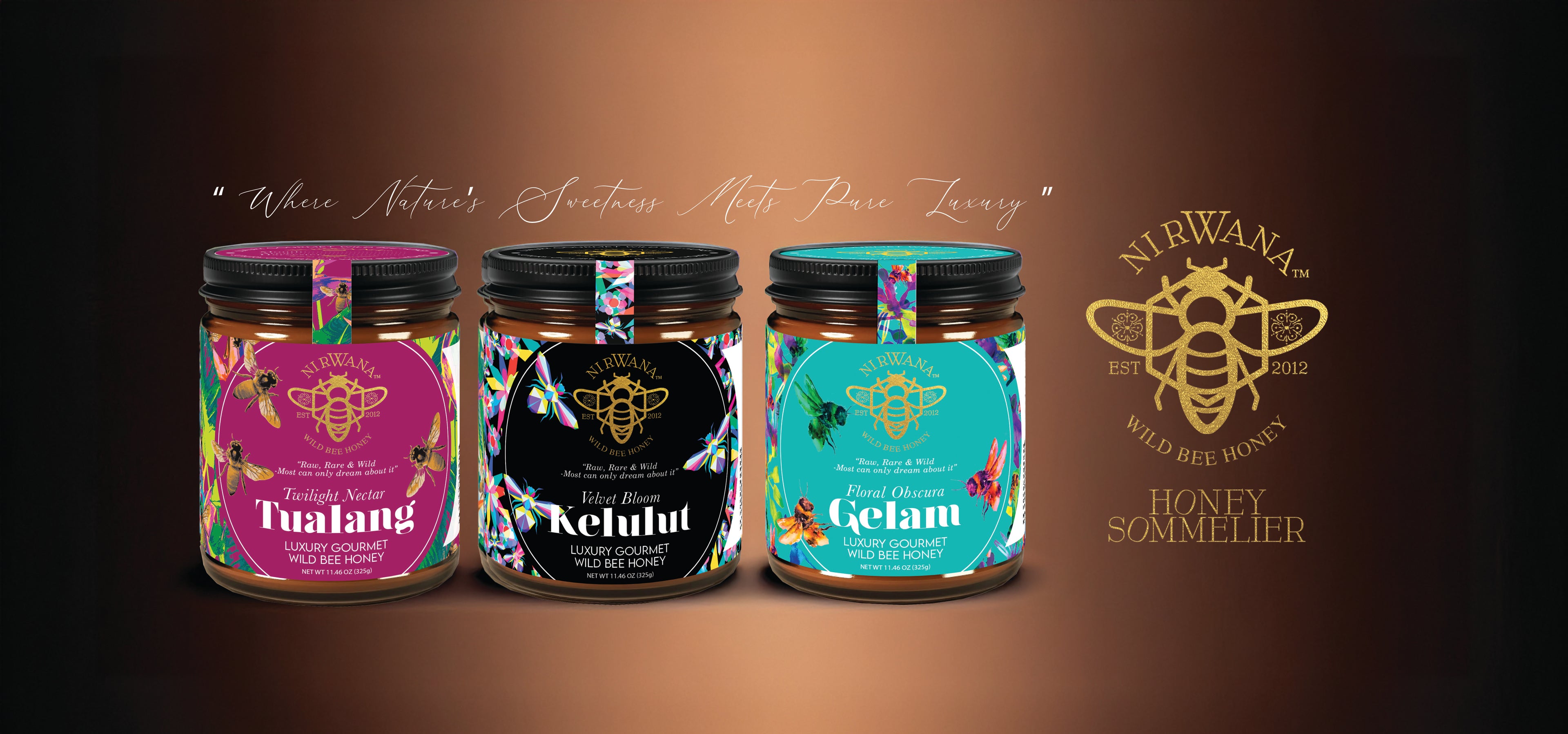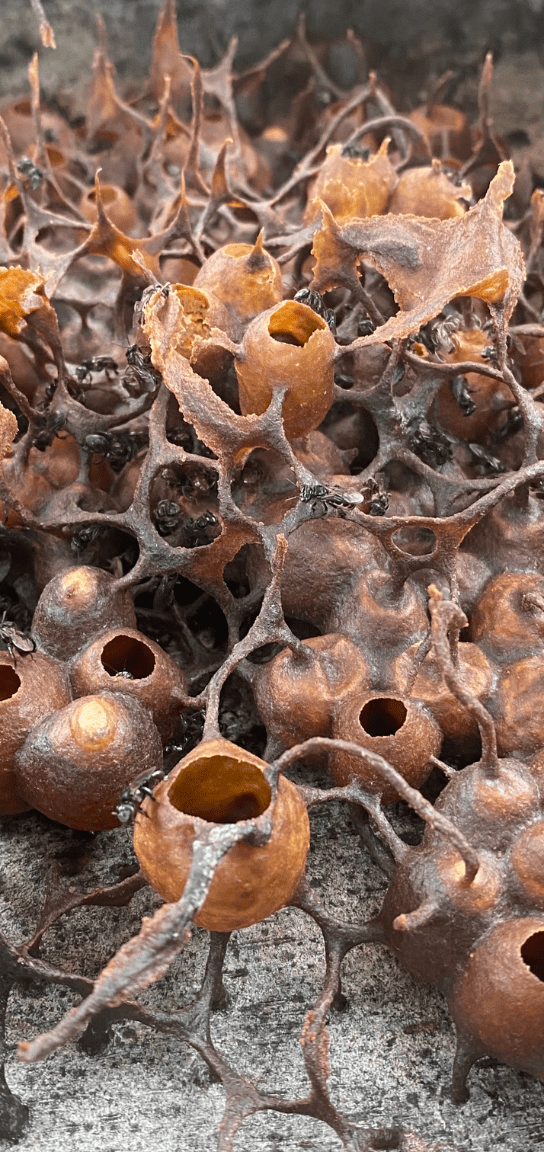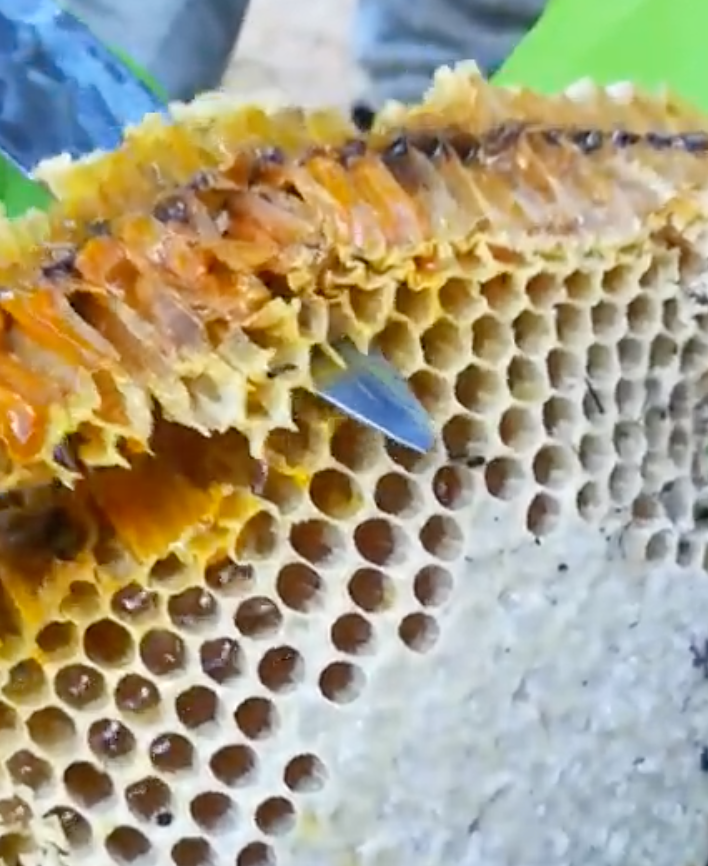The Gold Award Winning Kelulut Honey
Crafted by stingless bees, Kelulut Honey is a bold and vibrant experience. With its tangy, citrusy notes and a hint of earthy sweetness, this rare honey is both dynamic and healthful—a true gem in the world of gourmet honey.
Currently what we have now is a range of kelulut honey varieties produced by Heterotrigona itama and Geniotrigona thoracica. The honey is sourced mostly in the east coast of peninsular because we believe that there are many sources of wild food available in the area. The biodiversity in Malaysia has reduced to a certain number but yet this is the area where civilisation is difficult to carry because the people lives still depend on traditional jobs such as honey hunting, fishing and wild herbs finding.

Our kelulut taste varies from sourish-sweet to bitter and sour. However, because the honey is natural, we have not found one yet which we do not like the taste. It does not taste like your normal honey, it is an acquired taste for some, maybe due to the shock of its bitter and sourness, but in the end, many find it is a remarkable taste of honey and better yet it is packed with many health benefits.
There are so many researches have been done on kelulut but the one that we like and most recent is the one which researched on the ability of the honey to have the highest reducing sugar effect in your blood system. In the research, they found that kelulut Malaysia thanks to the our available of pollens in abundance, it has the highest amount of trehalulose - natural sucrose isomer. More information in available at the research link, please click above if you would like to find out more.

Kelulut honey hives are weird looking pods which is made of resins and pollens. That is the interesting part, because then the honey is infused in the pods with the benefits of the pollens which is then to say why kelulut is powerful and known as "the best" honey.



Untamed by industry. Shaped by forest. Honored by ritual.
Malaysia is home to some of the rarest and most complex honeys in the world and we’re here to help you taste them with intention.
At Eat Honey Pretty, we curate rainforest and native nectars that reflect the rich biodiversity of our ancient trees, coastal flora, and healing traditions. From rock bee honey harvested high in the jungle canopy to stingless bee nectar fermented in miniature forest chambers, each variety we carry tells a deeper story — of place, of season, of resilience.
Our honeys are never blended, diluted, or tamed. They’re raw, traceable, and vibrant — rich in antioxidants, living enzymes, and layered flavor signatures shaped by unspoiled forage and floral terroir.
These aren’t supermarket honeys.
They’re jungle-born, time-honored, and quietly potent.
Each jar is chosen not just for its taste, but for its ritual worth, how it soothes, strengthens, or connects whether taken by spoon, stirred into warm water, or woven into your daily rhythm.
This is the essence of what we call The Wild Standard.
And we’re proud to bring it to your table.

Tualang Honey: The Crown Jewel of the Jungle
Harvested from the canopies of 200-million-year-old rainforests, Tualang honey is the grand cru of the jungle — rare, commanding, and rich with wild layers.
It comes from Apis dorsata, the wild rock bee, whose nests can span over 2 meters wide and hang 80 meters high on the limbs of Tualang trees (Koompassia excelsa) — known locally as pokok tualang, the “skyscrapers” of Southeast Asia.
✧ What Makes It Different:
- Only harvestable 2–3 times a year due to seasonality and altitude.
- Harvesters (known as orang lebah) climb barefoot using smoke torches and ropes — a generational skill that is vanishing due to deforestation and risk.
- The bees’ nectar comes from deep, mixed dipterocarp forests — making every batch wildly multifloral and botanically unique.
✧ Cultural Notes:
- Used by royal herbalists and bomohs (traditional healers) for wound healing, postpartum care, and virility.
- Considered an “energetic honey” — grounding, masculine, and used in minyak urut (massage oils) for strength and stamina.
Taste Notes: Deep amber. Woody. Slightly bitter finish — like burnt caramel and forest bark.
Best Used In: Warm water tonics, restorative rituals, ceremonial sips.
Ritual Mood: Protection, grounding, masculine energy, deep reset.

Kelulut Honey : Tiny Bees, Powerful Nectar
Collected by stingless bees (Trigona itama), Kelulut honey is a living nectar — naturally fermented, tangy, and enzymatically alive. It’s thinner, sour, and emotionally vibrant — the champagne vinegar of honeys.
✧ What Makes It Different:
- Stored in resinous cerumen pods, not honeycomb — which imparts a subtle woody-resin flavor.
- Because of natural fermentation, it contains gluconic acid, propolis, and beneficial yeasts — ideal for gut health.
- These bees don’t sting — but they’re extremely selective. The hives are often hosted by traditional farmers in hollow logs.
✧ Cultural Notes:
- Traditionally gifted to women post-birth to boost immunity and energy.
- Once believed to bring “angin baik” (good wind) into the body — rebalancing inner temperament.
Taste Notes: Fruity tang. Fermented. Lingers like plum vinegar with floral lift.
Best Used In: Fasting rituals, immunity shots, skincare masks, digestive tonics.
Ritual Mood: Feminine, detoxifying, intuitive, clarifying.
Kelulut Honey Tasting – Tangy, Wild & A Little Witchy

Gelam Honey : Medicinal Nectar of the Coastal Forests
Harvested from the wetlands and tidal forests of Malaysia’s east coast, Gelam honey is a medicinal nectar steeped in botanical wisdom. It comes from bees foraging the blossoms of Melaleuca cajuputi, known locally as pokok gelam — a medicinal tree revered for its antibacterial oils, calming fragrance, and centuries-old healing uses.
Where Tualang soars, Gelam roots.
It is close to the earth, to water, to restoration.
The honey is highly fragrant, with an herbaceous lift that catches the nose the moment the bottle is opened — a soft signal of the power within.
✧ What Makes It Different:
- Foraged from coastal Melaleuca blooms, rich in terpenes and phenolic compounds similar to those in tea tree and eucalyptus.
- Highly antibacterial, anti-inflammatory, and clinically researched for wound healing, liver protection, and immune support.
- Naturally has a lower glycemic index and a strong antioxidant profile.
- One of the few Malaysian honeys with a distinct herbal-bitter profile, often favored by those who seek function before sweetness.
✧ Cultural Notes:
- Traditionally used by coastal and kampung communities for coughs, fever, skin healing, and digestive balance.
- The Gelam tree itself has long been used for traditional steam therapy, postpartum cleansing, and wound dressing.
- Seen as a feminine and balancing honey — lighter in color, but rich in healing character.
- Often blended into herbal tonics, or taken as a natural remedy by the spoon at dawn.
✧ Taste Notes:
Bright amber.
Herbaceous on the nose.
Softly bitter, with a floral-woody finish that lingers on the palate like coastal mist.
Scent-forward, grounding, slightly astringent.

With the Bees in Mind: Our Mindful Harvesting Ritual
At Eat Honey Pretty, we believe honey is a sacred gift from the bees, the land, and time itself. That’s why every step of our process is guided by intention, patience, and deep care. Every jar you hold in your hand is the result of harmony between human hands, buzzing wings, and blooming flowers. It’s not just honey. It’s a story of trust, tenderness, and transformation.
-
Mindful Harvest
We only harvest when the honey is ready. Never rushed, never forced. Our beekeepers observe the rhythm of the hives, waiting until the bees have sealed the combs with wax, their natural signal that the nectar has matured into true honey. We take only what the bees can spare, always leaving enough for their survival, health, and joy.
-
Demure Filtration
Once harvested, the honey goes through a slow, gentle filtration process just enough to remove debris, while preserving all the pollen, enzymes, and nutrients that make raw honey a living food. Nothing is rushed. Nothing is overheated. Everything is done in a quiet, clean space to respect the honey’s natural beauty.
-
Gentle and Hygienic Handling
We treat honey as we would a newborn. We handled with clean hands, sterilized tools, and utmost tenderness. From comb to jar, hygiene is our top priority, without ever compromising the integrity of the honey.
-
Delicious Finish, Thoughtful Bottling
Once settled, the honey is carefully bottled in small batches to retain freshness and character. No two jars are exactly the same, each carries its own seasonal notes, floral depth, and wild charm.
-
Elegant Storage
We store our honey like you’d store a treasure away from harsh lights, heat, or moisture. It rests in cool, quiet spaces until it's ready to meet you.
-


Crystallization and storage
If stored and maintained properly, honey will stay good indefinitely. Do not refrigerate. Store at room temperature (70-80 degrees °F) in a dark place to help retain its flavor, aroma, and consistency. Make sure the container remains sealed tightly. Keep clean by using a dry spoon each time you dip into the jar. This premium honey is raw, unprocessed, and unpasteurized. Therefore, it retains all the naturally occurring bioactive properties. It may become cloudy, but don’t worry! It’s still good! This is a totally normal process called “crystallization”. The superior quality remains intact and is perfectly safe to consume. If honey consistency becomes hard, don’t microwave it. Simply place jar in warm (not boiling) water and stir to soften.
From Jungle Gold to Everyday Sweet: A Comparative Table
Not all honey is created equal and not all sweetness tells the same story. This table offers a side-by-side comparison of the honeys we carry (Tualang, Kelulut, and Gelam) alongside more widely available commercial and international varieties.
It is designed to help you understand what sets forest-born, biodiverse honeys apart — in taste, origin, medicinal value, and ritual potential.
Here, you’ll discover how floral terroir, bee species, and harvesting traditions create radically different honeys from supermarket blends to rainforest elixirs.
This is not about ranking, but about revealing.
Because when you know what to look for, you taste more intentionally.

